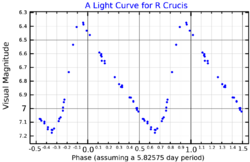Astronomy:R Crucis
| Observation data Equinox J2000.0]] (ICRS) | |
|---|---|
| Constellation | Crux |
| Right ascension | 12h 23m 37.68840s[2] |
| Declination | −61° 37′ 44.8570″[2] |
| Apparent magnitude (V) | 6.89[3] |
| Characteristics | |
| Spectral type | F6-G2Ib-II[4] or F7Ib/II[5] |
| B−V color index | 0.67±0.02[3] |
| Variable type | δ Cep[6] |
| Astrometry | |
| Radial velocity (Rv) | −13.5±3.0[3] km/s |
| Proper motion (μ) | RA: -9.404[2] mas/yr Dec.: −0.430[2] mas/yr |
| Parallax (π) | 1.98 ± 0.54[7] mas |
| Distance | approx. 1,600 ly (approx. 500 pc) |
| Details | |
| Radius | 44.6[8] R☉ |
| Surface gravity (log g) | 1.65[9] cgs |
| Temperature | 5,812±22[9] K |
| Metallicity [Fe/H] | +0.06[9] dex |
| Other designations | |
| Database references | |
| SIMBAD | data |
R Crucis is a variable star in the southern constellation of Crux. It has a yellow-white hue and is often too faint to see with the naked eye, having an apparent visual magnitude that fluctuates around 6.89.[3] This object is located at a distance of approximately 1,600 light years from the Sun based on parallax,[7] but it is drifting closer with a radial velocity of −13.5 km/s.[3]
This is a Classical Cepheid, or Delta Cephei variable, that ranges in brightness from visual magnitude 6.40 down to 7.23 with a period of 5.82575 days.[6] It is a supergiant star with a stellar classification that varies over each pulsation cycle, giving it a class range of F6-G2Ib-II.[4] The star has a mean radius 44.6 times the radius of the Sun (44.6 R☉), but the radius varies by 5 R☉ during each pulsation.[11] It has a near solar metallicity and the atmospheric abundances indicate it is likely past first dredge-up.[9]
A candidate companion star has been detected at an angular separation of 7.6″, which corresponds to a projected separation of 6,330 astronomical unit|AU. The Hubble WFC3 shows a closer companion at a separation of 1.9″.[12] The system is a source for X-ray emission but the contributing component is unclear.[13]
References
- ↑ Dean, J. F.; Cousins, A. W. J.; Bywater, R. A.; Warren, P. R. (January 1977). "VBI photometry of some southern cepheid and RR Lyrae variables". Memoirs of the Royal Astronomical Society 83: 69–93. Bibcode: 1977MmRAS..83...69D. https://ui.adsabs.harvard.edu/abs/1977MmRAS..83...69D. Retrieved 18 December 2021.
- ↑ 2.0 2.1 2.2 2.3 Brown, A. G. A. (August 2018). "Gaia Data Release 2: Summary of the contents and survey properties". Astronomy & Astrophysics 616: A1. doi:10.1051/0004-6361/201833051. Bibcode: 2018A&A...616A...1G. Gaia DR2 record for this source at VizieR.
- ↑ 3.0 3.1 3.2 3.3 3.4 Anderson, E.; Francis, Ch. (2012). "XHIP: An extended hipparcos compilation". Astronomy Letters 38 (5): 331. doi:10.1134/S1063773712050015. Bibcode: 2012AstL...38..331A.
- ↑ 4.0 4.1 Watson, Christopher (4 January 2010). "R Crucis". AAVSO Website. American Association of Variable Star Observers. http://www.aavso.org/vsx/index.php?view=detail.top&oid=10769. Retrieved 12 March 2014.
- ↑ Houk, Nancy (1979). Michigan catalogue of two-dimensional spectral types for the HD stars. 1. Ann Arbor, Michigan: Department of Astronomy, University of Michigan. Bibcode: 1978mcts.book.....H.
- ↑ 6.0 6.1 Samus, N. N. et al. (2017). "General Catalogue of Variable Stars". Astronomy Reports. 5.1 61 (1): 80–88. doi:10.1134/S1063772917010085. Bibcode: 2017ARep...61...80S.
- ↑ 7.0 7.1 van Leeuwen, F. (2007). "Validation of the new Hipparcos reduction". Astronomy and Astrophysics 474 (2): 653–664. doi:10.1051/0004-6361:20078357. Bibcode: 2007A&A...474..653V.
- ↑ Moskalik, P.; Gorynya, N. A. (2005). "Mean Angular Diameters and Angular Diameter Amplitudes of Bright Cepheids". Acta Astronomica 55: 247. Bibcode: 2005AcA....55..247M.
- ↑ 9.0 9.1 9.2 9.3 Usenko, I. A. et al. (July 2014). "Spectroscopic studies of southern-hemisphere Cepheids: Three Cepheids in Crux (BG Cru, R Cru, and T Cru)". Astronomy Letters 40 (7): 435–448. doi:10.1134/S106377371407007X. Bibcode: 2014AstL...40..435U.
- ↑ "R Cru". SIMBAD. Centre de données astronomiques de Strasbourg. http://simbad.u-strasbg.fr/simbad/sim-basic?Ident=R+Cru.
- ↑ Moskalik, P.; Gorynya, N. A. (June 2005). "Mean Angular Diameters and Angular Diameter Amplitudes of Bright Cepheids". Acta Astronomica 55: 247–260. Bibcode: 2005AcA....55..247M.
- ↑ Evans, Nancy Remage et al. (May 2016). "Hubble Space Telescope Snapshot Survey for Resolved Companions of Galactic Cepheids". The Astronomical Journal 151 (5): 14. doi:10.3847/0004-6256/151/5/129. 129. Bibcode: 2016AJ....151..129E.
- ↑ Engle, Scott G. et al. (March 2017). "The Secret Lives of Cepheids: δ Cep—The Prototype of a New Class of Pulsating X-Ray Variable Stars". The Astrophysical Journal 838 (1): 9. doi:10.3847/1538-4357/aa6159. 67. Bibcode: 2017ApJ...838...67E.
 |


